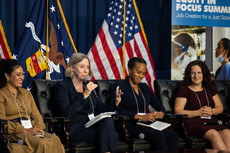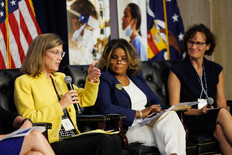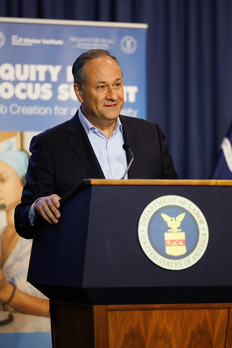|
Click here to view in browser
Last week, the Women’s Bureau co-hosted the “Equity in Focus Summit” with the Worker Institute at Cornell’s ILR School. The day-long summit, held on September 22 at the U.S. Department of Labor’s headquarters in Washington, focused on the importance of gender and racial equity in the workforce. Speakers and panelists discussed the importance of gender and racial equity in policymaking and workforce development, with a focus on promising policies and programs at the national, regional, state and local levels. More than 1,000 attendees joined in person or via livestream to hear distinguished speakers including Second Gentleman Douglas Emhoff, Deputy Secretary of Labor Julie Su, and Women’s Bureau Director Wendy Chun-Hoon. Secretary of Labor Marty Walsh and AFL-CIO President Liz Shuler shared pre-recorded remarks.
 |
|
Federal leaders discussed current and future infrastructure investments, ways to embed gender and racial equity in funding opportunities, and how funding can be used to create a more diverse and just workforce. |
 |
|
Panelists shared tested and effective strategies to recruit and retain women and women of color in the trades and nontraditional occupations. |
 |
|
Plenary participants spoke on fair wages/compensation for care workers, job quality for both formal and informal care providers, access to childcare/elder care for workers, and expanding care for those working in hospitality and the trades. |
 |
|
Second Gentleman Doug Emhoff offered closing remarks for the morning portion of the Summit, underscoring the value of public-private partnerships in creating avenues for women to high-quality, good paying jobs—and equal pay and fair compensation in those jobs. "When we lift women up, we lift up the economy," Mr. Emhoff said. "All these things are not women's issues; they're issues for all of us." |
If you missed the Equity in Focus Summit live, catch it here:
Watch the livestream
Read the readout
Learn more about federal investments in good jobs
On September 19, Women's Bureau Acting Deputy Director Tiffany Boiman spoke at the Center for Workforce Inclusion's inaugural equity summit, “The Intersection of Age, Race, and Gender,” in Washington. The summit explored ways older workers are excluded or left behind by current workforce development programs. Recent data from the U.S. Bureau of Labor Statistics distilled in a new Women's Bureau factsheet shows that two years into the pandemic, job recovery for women ages 65 and older remains slow across all racial and ethnic groups. Summit participants shared ideas for challenging bias against older workers in the workforce and promoting their economic recovery.
The U.S. Department of Labor has awarded $2 million thorough its Fostering Access Rights and Equity (FARE) grant program to support efforts by six non-profit organizations to help women who are paid low wages understand and exercise their employment rights and benefits. Administered by the department's Women’s Bureau and Employment and Training Administration, the FARE grants will help connect women who are paid low wages to community services, benefits and legal assistance.
Labor Day
Observed on the first Monday in September, Labor Day recognizes the contributions and achievements of American workers. Formalized by President Grover Cleveland in 1894, Labor Day honors the workers who are helping to build a strong economy. Today, women represent 47 percent of the labor force and continue to face challenges tied to childcare responsibilities, unequal pay, overrepresentation in undervalued industries, and more—difficulties that have been intensified by the pandemic. This year, as we celebrate the 9.5 million jobs that have been added to the economy since President Biden took office, the Women’s Bureau continues to push for gender and racial equity for millions of women workers who help make our economy stronger.
Hispanic Heritage Month
In honor of Hispanic Heritage Month, held annually September 15–October 15, the Women’s Bureau hosted a webinar titled “Jobs and the Economy: Advancing Equity for Latinas in the Workplace” on September 19. The program, which featured leaders from across the country, addressed the challenges and barriers Latinas face in the workforce and offered solutions to increase Latina workers' access to higher paying jobs.
Black Women's Equal Pay Day
The Equal Pay Act of 1963 modified the Fair Labor Standards Act of 1938 to include protections against pay discrimination based on sex. Although the Equal Pay Act was intended to keep employers from paying men and women different wages for equal work, a significant wage gap still persists. In 2021, women who worked full-time year-round were paid an average of nearly $10,000 less per year than men. And on average Black women were paid nearly $23,000 less than white men, even when working full-time year-round.
National Truck Driver Appreciation Week
This year, we celebrated National Truck Driver Appreciation Week, September 11–17, in recognition of the millions of professional truckers across the country. Earlier this year, Brita Nowak, who has been a trucker for more than 20 years, invited the Women's Bureau for a ride-along and shared her experiences as a woman in the trucking industry.
Each year on National Working Parents Day, September 16, we acknowledge the sacrifices and dedication of working parents. Recent data shows that mothers’ employment has recovered more slowly throughout the pandemic and is still 1.6% below where it was in February 2020, while fathers’ employment has fully recovered and is now even higher than it was before the pandemic. And as recently as August 2022, millions of women in households with children reported experiencing at least one type of work disruption such as having to work reduced hours, taking leave, or losing a job due to lack of childcare.
 |
|
Two Years into the Pandemic, Women Ages 65 and Older Had Yet to Recover Their COVID-Related Employment Losses
Before the pandemic, women age 65 and older were a growing share of the female workforce, but their employment rates dropped sharply between April 2019 and April 2020 with the onset of the pandemic. What factors were responsible for older women’s slow economic recovery, and what are the long-term implications for their retirement security?
|
 |
|
'Steps to Improve Women’s Retirement Security' Webcast
Women face unique challenges when it comes to saving for retirement, including the responsibility of being the primary family caregiver, overrepresentation in undervalued and underpaid sectors of the economy, and persistent wage gaps and pay inequities. Women’s Bureau Acting Deputy Director Tiffany Boiman joined speakers from the Department of Labor’s Employee Benefits Security Administration and nonprofit organization Women's Institute For A Secure Retirement for a webcast on September 20 to discuss strategies women can employ to help build their retirement security.
|
Cornell Chronicle: Equity in Focus Summit
Pacific Daily News: Information Sessions to Help Identify and Stop Workplace Harassment
Plan Adviser: DOL to Host Webinar on Women’s Retirement Security
Star Advertiser: Column_Supporting Women in Workplaces is Integral to Economic Strength
The Tennesean: 4 Things to Know about Workforce Development in Middle Tennessee
Frontline Flexibility: The Benefits of Fair Scheduling for Workers and Business
Labor Secretary Marty Walsh will join Rep. Rosa DeLauro, researchers, workers and business owners for a conversation about scheduling flexibility for hourly and frontline workers, its impact on job quality and solutions for fair scheduling practices that improve workers’ lives and economic stability.
Uniting to End GBVH in the World of Work: Collaboration through Legislation and Bargaining
The ILO Office for the USA and Canada, in collaboration with the U.S. Department of Labor’s Women’s Bureau, will host a virtual roundtable on how local officials, workers’ rights advocates and employer representatives are adopting legislation, collective bargaining language and worker-focused policies to address gender-based violence and harassment in the world of work.
“Occupational segregation” is the gendered sorting of men and women into different types of jobs. It leads to women being overrepresented in certain jobs, which are valued and compensated less than male-dominated jobs.
We’ve heard from many working women about their experiences with gendered job expectations, the challenges they face at work, the support systems that help them thrive and the policy changes that would help them succeed. We'd like to hear from you.
 |
|
The Women’s Bureau has championed the rights of working women and served as a convener of conversations critical to an equitable economy for women for more than 100 years.
Follow us at @WB_DOL to view our #ThrowbackThursday series highlighting pioneering women, and to learn more about the latest research, initiatives, policies and updates related to working women and their families.
|
Click here to view in browser
|